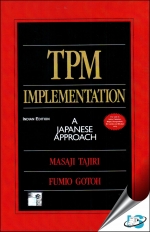Total Productive Maintenance (TPM) is a new approach to plant maintenance that combines productive maintenance with total quality control and employee involvement. This expert guide offers you a proven, step-by-step program for implementing TPM on various types of manufacturing shop floors, especially in the equipment-oriented assembly industry.
You'll find complete information on basic TPM concepts, and learn about the seven steps to autonomous maintenance: initial cleaning ... equipment improvement ... effective lubrication ... overall inspection ... achieving zero breakdowns ... achieving zero defects ... and maintaining autonomous super-vision once goals are attained.
TPM Implementation features:
-
Comprehensive guidance on implementing a TPM program in any plant
-
Special instructions for applying the TPM concept to repetitive manual work such as the automobile assembly process
-
A detailed look at quality control as it is practiced on the factory floor
-
Case studies from Toyota, Asai Glass, Bridgestone, Hitachi, and other Japanese firms
This essential sourcebook will give you the tools you need to correct undesirable conditions on the shop floor, improve frontline engineering and plant operations, and educate plant personnel in order to achieve zero quality defects.
Preface
Introduction
Chapter 1 : TPM Aims at the Elimination of Losses
-
1.1 : The Shopfloor Suffers from Diverse Mistakes
-
1.2 : The Shopfloor is Flooded with Losses
-
1.3 : Understanding the Nature of Losses
-
1.4 : Why Losses Occur
Chapter 2 : A Summary of TPM
-
2.1 : Six Major TPM Activities
-
2.2 : The Effects and an Evaluation of TPM
-
2.3 : The TPM Master Plant
-
2.4 : The TPM Steering Organization
Chapter 3 : The Five Countermeasures to Achieve Zero Breakdowns
-
3.1 : The Basic Strategy to Attain Zero Breakdowns
-
3.2 : Who Takes the Five Countermeasures?
-
3.3 : Restructuring the Roles of the Production and Maintenance Departments
-
3.4 : Allocating Roles to the Production and Maintenance Departments
Chapter 4 : The Autonomous Maintenance Program
-
4.1 : The Aims of Autonomous Maintenance
-
4.2 : The Autonomous Maintenance Development Program
-
4.3 : The Step-by-Step Development of Autonomous Maintenance
-
4.4 : Work Procedures and Standards
-
4.5 : Educational Systems in Autonomous Maintenance
-
4.6 : Notes for Successful TPM Implementation
-
4.7 : The Twelve Keypoints of Autonomous Maintenance
Chapter 5 : Step 1 : Initial Cleaning
-
5.1 : Aims from the Equipment Perspective
-
5.2 : Aims from the Human Perspective
-
5.3 : How to Develop Step 1
-
5.4 : How to Proceed with Initial Cleaning
-
5.5 : Case Study
-
5.6 : The Keypoints of an Autonomous Maintenance Audit
Chapter 6 : Step 2 : Countermeasures to Sources of Contamination
-
6.1 : Aims from the Equipment Perspective
-
6.2 : Aims from the Human Perspective
-
6.3 : Time Targets for Cleaning and Tentative Standards
-
6.4 : How to Develop Step 2
-
6.5 : Case Study
-
6.6 : The Keypoints of an Autonomous Maintenance Audit
Chapter 7 : Step 3 : Cleaning and Lubricating Standards
-
7.1 : Aims from the Equipment Perspective
-
7.2 : Aims from the Human Perspective
-
7.3 : How to Develop Step 3
-
7.4 : Establish a Lubrication Control System
-
7.5 : Case Study
-
7.6 : The Keypoints of an Autonomous Maintenance Audit
-
7.7 : Review the First Stage of the Autonomous Maintenance Program
Chapter 8 : Step 4 : Overall Inspection
-
8.1 : Aims from the Equipment Perspective
-
8.2 : Aims from the Human Perspective
-
8.3 : The Necessity of Overall Inspection
-
8.4 : How to Develop an Overall Inspection
-
8.5 : Case Study
-
8.6 : The Keypoints of an Autonomous Maintenance Audit
Chapter 9 : Step 5 : Autonomous Maintenance Standards
-
9.1 : Aims from the Equipment Perspective
-
9.2 : Aims from the Human Perspective
-
9.3 : Finishing the Activities Relating to Equipment
-
9.4 : How to Develop Step 5
-
9.5 : Routine Inspection by Autonomous Maintenance
-
9.6 : Preparing Autonomous Maintenance Standards
-
9.7 : Case Study
-
9.8 : The Keypoints of an Autonomous Maintenance Audit
Chapter 10 : Step 6 : Process Quality Assurance
-
10.1 : Aims from the Equipment Perspective
-
10.2 : Aims from the Human Perspective
-
10.3 : The Challenge of Zero Defects
-
10.4 : A Prerequisite for Process Quality Assurance
-
10.5 : Step 6-1 : Remedies Focused on Quality Results
-
10.6 : Step 6-2 : Remedies Focused on Quality Causes
-
10.7 : Step 6-3 : Establish Process Quality Assurance
-
10.8 : The Keypoints of an Autonomous Maintenance Audit
Chapter 11 : Step 7 : Autonomous Supervision
-
11.1 : TPM Fully Established on the Shopfloor
-
11.2 : Maintaining the Current TPM Level
-
11.3 : Aiming at a Higher Level of TPM
Chapter 12 : Autonomous Maintenance in Manual Work Departments
-
12.1 : The Basic Concepts of Autonomous Maintenance
-
12.2 : How to Develop Autonomous Maintenance
-
12.3 : How to Construct the Seven-Step Programs
-
12.4 : Autonomous Maintenance in the Assembly Department
-
12.5 : Autonomous Maintenance in the Inspection Department
-
12.6 : Autonomous Maintenance in the Material Handling Department
Glossary
Bibliography
Index

























